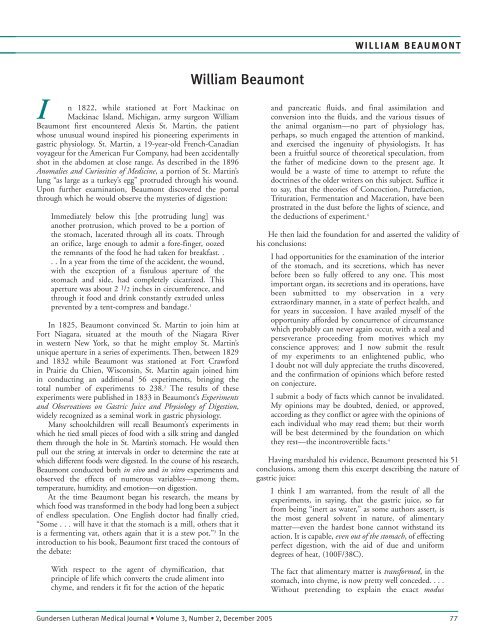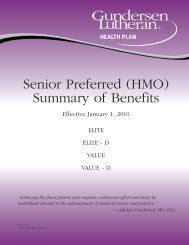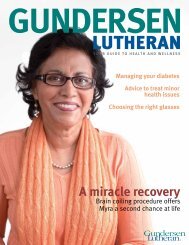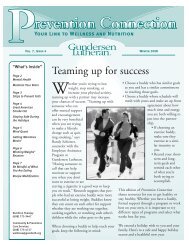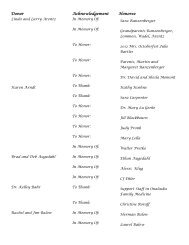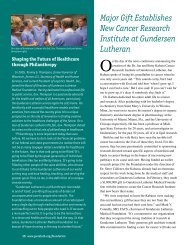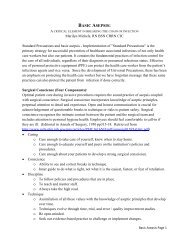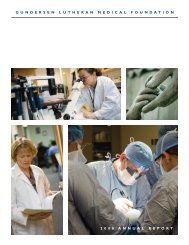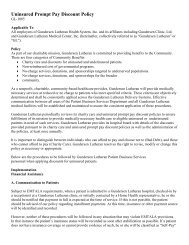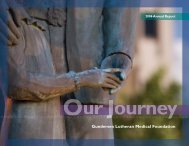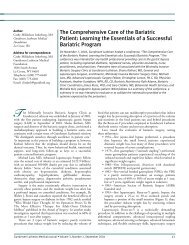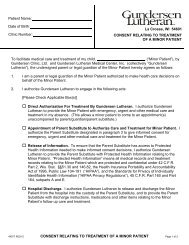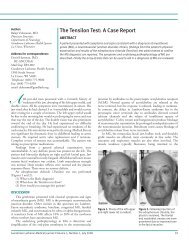Medical Journal vol.2 no.2 - Gundersen Health System
Medical Journal vol.2 no.2 - Gundersen Health System
Medical Journal vol.2 no.2 - Gundersen Health System
Create successful ePaper yourself
Turn your PDF publications into a flip-book with our unique Google optimized e-Paper software.
WILLIAM BEAUMONT<br />
I<br />
n 1822, while stationed at Fort Mackinac on<br />
Mackinac Island, Michigan, army surgeon William<br />
Beaumont first encountered Alexis St. Martin, the patient<br />
whose unusual wound inspired his pioneering experiments in<br />
gastric physiology. St. Martin, a 19-year-old French-Canadian<br />
voyageur for the American Fur Company, had been accidentally<br />
shot in the abdomen at close range. As described in the 1896<br />
Anomalies and Curiosities of Medicine, a portion of St. Martin’s<br />
lung “as large as a turkey’s egg” protruded through his wound.<br />
Upon further examination, Beaumont discovered the portal<br />
through which he would observe the mysteries of digestion:<br />
Immediately below this [the protruding lung] was<br />
another protrusion, which proved to be a portion of<br />
the stomach, lacerated through all its coats. Through<br />
an orifice, large enough to admit a fore-finger, oozed<br />
the remnants of the food he had taken for breakfast. .<br />
. . In a year from the time of the accident, the wound,<br />
with the exception of a fistulous aperture of the<br />
stomach and side, had completely cicatrized. This<br />
aperture was about 2 1 /2 inches in circumference, and<br />
through it food and drink constantly extruded unless<br />
prevented by a tent-compress and bandage. 1<br />
In 1825, Beaumont convinced St. Martin to join him at<br />
Fort Niagara, situated at the mouth of the Niagara River<br />
in western New York, so that he might employ St. Martin’s<br />
unique aperture in a series of experiments. Then, between 1829<br />
and 1832 while Beaumont was stationed at Fort Crawford<br />
in Prairie du Chien, Wisconsin, St. Martin again joined him<br />
in conducting an additional 56 experiments, bringing the<br />
total number of experiments to 238. 2 The results of these<br />
experiments were published in 1833 in Beaumont’s Experiments<br />
and Observations on Gastric Juice and Physiology of Digestion,<br />
widely recognized as a seminal work in gastric physiology.<br />
Many schoolchildren will recall Beaumont’s experiments in<br />
which he tied small pieces of food with a silk string and dangled<br />
them through the hole in St. Martin’s stomach. He would then<br />
pull out the string at intervals in order to determine the rate at<br />
which different foods were digested. In the course of his research,<br />
Beaumont conducted both in vivo and in vitro experiments and<br />
observed the effects of numerous variables—among them,<br />
temperature, humidity, and emotion—on digestion.<br />
At the time Beaumont began his research, the means by<br />
which food was transformed in the body had long been a subject<br />
of endless speculation. One English doctor had finally cried,<br />
“Some . . . will have it that the stomach is a mill, others that it<br />
is a fermenting vat, others again that it is a stew pot.” 3 In the<br />
introduction to his book, Beaumont first traced the contours of<br />
the debate:<br />
With respect to the agent of chymification, that<br />
principle of life which converts the crude aliment into<br />
chyme, and renders it fit for the action of the hepatic<br />
William Beaumont<br />
and pancreatic fluids, and final assimilation and<br />
conversion into the fluids, and the various tissues of<br />
the animal organism—no part of physiology has,<br />
perhaps, so much engaged the attention of mankind,<br />
and exercised the ingenuity of physiologists. It has<br />
been a fruitful source of theoretical speculation, from<br />
the father of medicine down to the present age. It<br />
would be a waste of time to attempt to refute the<br />
doctrines of the older writers on this subject. Suffice it<br />
to say, that the theories of Concoction, Putrefaction,<br />
Trituration, Fermentation and Maceration, have been<br />
prostrated in the dust before the lights of science, and<br />
the deductions of experiment. 4<br />
He then laid the foundation for and asserted the validity of<br />
his conclusions:<br />
I had opportunities for the examination of the interior<br />
of the stomach, and its secretions, which has never<br />
before been so fully offered to any one. This most<br />
important organ, its secretions and its operations, have<br />
been submitted to my observation in a very<br />
extraordinary manner, in a state of perfect health, and<br />
for years in succession. I have availed myself of the<br />
opportunity afforded by concurrence of circumstance<br />
which probably can never again occur, with a zeal and<br />
perseverance proceeding from motives which my<br />
conscience approves; and I now submit the result<br />
of my experiments to an enlightened public, who<br />
I doubt not will duly appreciate the truths discovered,<br />
and the confirmation of opinions which before rested<br />
on conjecture.<br />
I submit a body of facts which cannot be invalidated.<br />
My opinions may be doubted, denied, or approved,<br />
according as they conflict or agree with the opinions of<br />
each individual who may read them; but their worth<br />
will be best determined by the foundation on which<br />
they rest—the incontrovertible facts. 4<br />
Having marshaled his evidence, Beaumont presented his 51<br />
conclusions, among them this excerpt describing the nature of<br />
gastric juice:<br />
I think I am warranted, from the result of all the<br />
experiments, in saying, that the gastric juice, so far<br />
from being “inert as water,” as some authors assert, is<br />
the most general solvent in nature, of alimentary<br />
matter—even the hardest bone cannot withstand its<br />
action. It is capable, even out of the stomach, of effecting<br />
perfect digestion, with the aid of due and uniform<br />
degrees of heat, (100F/38C).<br />
The fact that alimentary matter is transformed, in the<br />
stomach, into chyme, is now pretty well conceded. . . .<br />
Without pretending to explain the exact modus<br />
<strong>Gundersen</strong> Lutheran <strong>Medical</strong> <strong>Journal</strong> • Volume 3, Number 2, December 2005 77
operandi of the gastric fluid, yet I am impelled by the<br />
weight of evidence, afforded by the experiments,<br />
deductions and opinions of the ablest physiologists,<br />
but more by direct experiment, to conclude that the<br />
change effected by it on aliment is purely chemical. We<br />
must, I think, regard this fluid as a chemical agent, and<br />
its operation as a chemical action.<br />
The decay of the dead body is a chemical operation,<br />
separating it into its elementary principles—and why<br />
not the solution of aliment in the stomach, and its<br />
ultimate assimilation into fibrine, gelatine and<br />
albumen? Matter, in a natural sense, is indestructible.<br />
It may be differently combined; and these<br />
combinations are chemical changes. It is well known<br />
that all organic bodies are composed of very few simple<br />
principles, or substances, modified by excess or<br />
diminution of some of their constituents.<br />
The gastric juice appears to be secreted from numberless<br />
vessels, distinct and separate from the mucous follicles.<br />
These vessels, when examined with a microscope,<br />
appear in the shape of small lucid points, or very fine<br />
papillae, situated in the interstices of the follicles. They<br />
discharge their fluid only when solicited to do so, by the<br />
presence of aliment, or by mechanical irritation.<br />
Pure gastric juice, when taken directly out of the stomach<br />
of a healthy adult, unmixed with any other fluid, save a<br />
portion of the mucus of the stomach with which it is<br />
most commonly, and perhaps always combined, is a<br />
clear, transparent fluid; inodorous; a little saltish; and<br />
very perceptibly acid. Its taste, when applied to the<br />
tongue, is similar to thin mucilaginous water, slightly<br />
acidulated with muriatic acid. It is readily diffusible in<br />
water, wine or spirits; slightly effervesces with alkalis; and<br />
is an effectual solvent of the materia alimentaria. It<br />
possesses the property of coagulating albumen, in an<br />
eminent degree; is powerfully antiseptic, checking the<br />
putrefaction of meat; and effectually restorative of<br />
healthy action, when applied to old, fetid sores, and foul,<br />
ulcerating surfaces. 4<br />
Working in the most primitive of conditions and far from<br />
the recognized centers of medical knowledge, Beaumont<br />
nonetheless, through careful design, observation,<br />
documentation, and analysis, resolved many of the questions<br />
about the physiology of digestion.<br />
REFERENCES<br />
1. Gould GM, Pyle WL. Anomalies and Curiosities of Medicine: Being an<br />
encyclopedic collection of rare and extraordinary cases, and of the most striking<br />
instances of abnormality in all branches of medicine and surgery, derived from an<br />
exhaustive research of medical literature from its origin to the present day,<br />
abstracted, classified, annotated, and indexed. Philadelphia, Pa: WB Saunders;<br />
1896; 631. Available at: http://etext.lib.virginia.edu/etcbin/toccernew2?id=GouAnom.sgm&images=images/modeng&data=/texts/english/mode<br />
ng/parsed&tag=public&part=12&division=div1.<br />
2. Katch FI. History makers. Available at http://www.sportsci.org/news/history/<br />
beaumont/beaumont.html.<br />
3. Quoted in Lienhard JH. Engines of our ingenuity, No. 774: William<br />
Beaumont. Available at: http://www.uh.edu/engines/epi774.htm.<br />
4 Beaumont W. Experiments and Observations on Gastric Juice and the Physiology<br />
of Digestion. Plattsburgh, NY: FP Allen; 1833. In: Katch. I. History makers.<br />
Available at: http://www.sportsci.org/news/history/beaumont/beaumont.html.<br />
Author:<br />
Cathy Mikkelson Inderberg, MA<br />
<strong>Gundersen</strong> Lutheran<br />
<strong>Medical</strong> Foundation<br />
La Crosse, Wis<br />
Address for correspondence:<br />
Cathy Mikkelson Inderberg, MA<br />
FB0-003<br />
Gunderson Lutheran <strong>Medical</strong><br />
Foundation<br />
1836 South Avenue<br />
La Crosse, WI 54601<br />
Telephone: (608) 775-6648<br />
Fax: (608) 775-6601<br />
Email: clinderb@gundluth.org<br />
One-Footed Gull<br />
Photograph by Gregory G. Fischer, MD<br />
<strong>Gundersen</strong> Lutheran<br />
78 <strong>Gundersen</strong> Lutheran <strong>Medical</strong> <strong>Journal</strong> • Volume 3, Number 2, December 2005


